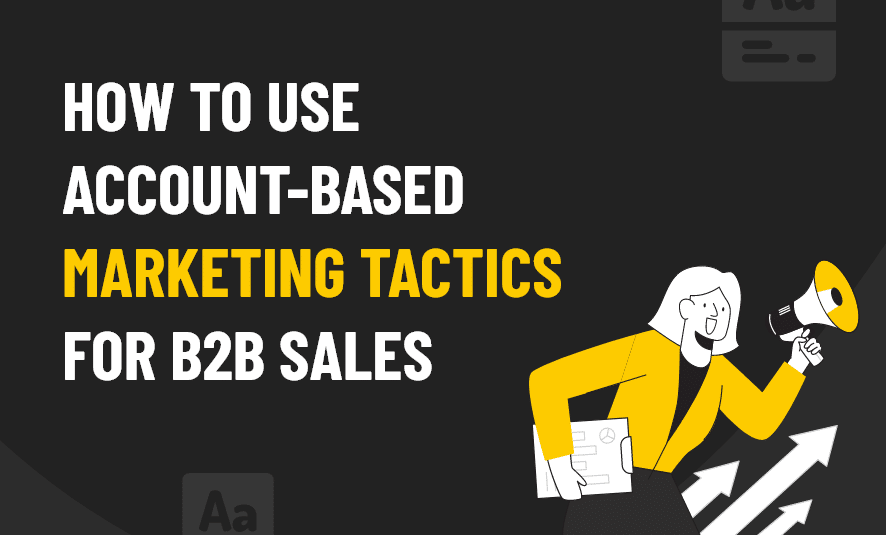Many experts predicted that account-based selling would be a fad, but the approach has actually turned out to be a very effective way to generate leads for your business.
According to the State of Marketing Report by Hubspot, 67% of brands have started using an account-based strategy as part of their overall lead generation efforts. The interesting thing is that almost two-thirds of these professionals say they’ve made more inbound requests via their targeted email lists as a result of this strategy.
What’s more, almost 90% of companies say account-based practices have helped them develop better working relationships with their leads. Therefore, it only makes sense to look at how you can use account-based marketing tactics within your next B2B sales campaign.
Account-Based Marketing Best Practices to Rock Your B2B Sales
1. Build a strong target account list.
Bulk email, often known as mass email, is an email message sent to a large number of people at once. Sending a message to all or a portion of your subscribers can be a quick and efficient way to get the word out about breaking news or time-sensitive upgrades that affect your company and customers. With the correct level of personalization, it can also sometimes be used to send a marketing message based around a special event, sale or other theme.
2. Pay special attention to high-value accounts
In account-based marketing, you invest more time and resources into a select group of highly valuable accounts instead of distributing your efforts across a wider audience.
To do this, you must become better acquainted with the accounts you want to target. You can then create personalized content, campaigns, and communications that address their specific goals and challenges. When you are able to tailor your offerings, your relevance among these key accounts is maximized.
3. Keep your marketing and sales team in sync.
It’s no secret that B2B marketing and sales teams have had trouble aligning their priorities and goals. Marketing departments often measure success by numbers of likes and follows, while sales teams look for ROI and revenue. But when you want to implement account-based marketing tactics for your B2B strategy, these misaligned goals can cause big problems.
Therefore, make it a point to keep your sales and marketing teams aligned in their messaging, tactics, and goals. For example, both the departments need to agree on how a target account will be segmented, what resources will be allocated for that account, and what responsibilities each team will take on as part of the campaign. It’s also important that the teams agree on how success will be measured.
When both teams have a clear idea of what they’re working towards and how they’ll work together, everyone is more productive and able to focus their time and energy on executing activities designed to drive results.
4. Design offers that will land you meetings with your prospects
5. Create personalized cold email campaigns
First, get yourself a good list of targeted companies that you want to do business with and develop a strategy for reaching out cold. Prepare an email that is both personalized and direct:
- Tell the company about yourself and your company.
- State your purpose for contacting them.
- Provide an interest-gated offer of some kind.
Make sure you give them a way of responding without being intrusive—if they’re interested they’ll let you know.
6. One-to-one C-level campaigns can work wonders for your ABM strategy
If you assign employees the responsibility for cultivating relationships with specific buyer personas at their target accounts, it can result in a more personalized experience for the target account.
However, keep in mind that C-level executives are busy people and that they might not always respond to your outreach immediately. In order to help them get acquainted with your company and its offerings, you might want to consider scheduling a demo or inviting them to an event or webinar (—something where they have time to see what you have to offer).
7. Content syndication can help you warm up your leads
8. Use intent data to find potential buyers
Finding the right people to target is one of the most important parts of an ABM strategy. If you don’t have the right accounts, even a perfectly executed account-based marketing strategy won’t have a significant impact.
Enter intent data. It’s a great way to get insights into the behavior of your most qualified prospects, enabling you to target them with tailored outreach.
For example, if you sell cloud storage solutions to small businesses, how do you use intent data to find companies with a need for such a solution? You might start by looking at all companies that are in the market for cloud-based solutions by looking at their overall consumption of content related to cloud computing. This can give you a long list of potential candidates.
But it’s not enough just to look at cloud computing in general — you also have to understand what types of cloud computing they’re interested in. From that perspective, you can see all companies whose employees have been consuming content about SaaS storage solutions or hybrid storage solutions or enterprise storage solutions, or whatever other criteria you think would be relevant. This principle would also apply with regard to other cloud-based solutions such as for accounting, finance, CRM, etc
9. Retargeting can keep your brand in front of potential accounts
Retargeting is a great way to repeatedly engage a specific account as its employees consume online content. Some retargeting innovations are directly applicable to account-based marketing programs.
Dynamic creative targeting, for example, allows you to display different images and messages to each viewer of your ad, based on their browsing behavior. Dynamic audience targeting, on the other hand, enables you to target people who have performed specific actions on your website.
10. Utilize your channels wisely
- Blog: If you’re writing a blog, it’s important to understand what kind of tone the audience expects from that blog and to stay true to that tone.
- Email: When you’re writing an email sequence, make sure you’re specific about what action you want the reader to take. Be strategic about when and how often they should be receiving emails from you, and personalize it as much as possible.
- Social media: In social media posts, make sure to keep your copy short and sweet. Use language that is familiar and friendly but still professional. Don’t waste space on fancy words when simpler ones will do just fine.
- Product description: On product descriptions, find ways to show off the product without listing every single feature. Focus on what makes the product different from others like it, and why it will benefit the customer in a way that other products don’t.
- Case study: In case studies, focus on facts over hype or opinion. Your goal is not only to inform the reader but also show them how other companies have benefitted from your service or product.
11. Measure your account-based marketing success
Let’s take a look at some of the metrics you should be tracking as part of your account-based marketing program:
- Revenue generated. This seems like an obvious metric, but it’s important to remember that ABM is about influencing revenue, not immediately generating it. You can’t expect a huge increase in revenue after one campaign — it will take time to see the results.
- Revenue per account (RPA). This measurement shows how effective your efforts are at converting target accounts into customers who pay for your products or services
- Leads. If you’re doing a good job of targeting your prospects, you should see a significant increase in the number of high-quality sales leads that come through your funnel.
- Engagement Rate. Are you seeing an increase in engagement on your website? Is there more activity on your social media pages? Are people clicking through your emails? If they’re not engaging with your content, you may need to adjust your messaging or re-evaluate which accounts you’re targeting.
- Quality of new sales opportunities created. Not all sales opportunities are created equal; some have a better chance of converting than others. Are the leads generated by your account-based marketing strategy meeting or exceeding the quality of leads from other methods?
- Account engagement metrics: Account engagement can be measured in a number of ways, including the number of calls, email opens and clicks, video views, web visits and downloads. You may also want to track the number of meetings scheduled with each account as well as the deal size for those meetings.
- Account win rates: This metric is especially important because it shows how many deals are actually won from each account once they come into your pipeline.
What are the Benefits of Account-Based Marketing (ABM) for B2B Sales?
Account-based marketing is a growing B2B sales tactic for businesses seeking to cut through the noise and get straight to the accounts that matter most to their business.
But, if you are still wondering if it’s right for your B2B sales, we have listed a few benefits below:
1. More opportunities.
It’s not just about one person; it’s about an entire team and the ripple effect an account can create once your solution drives value for them. ABM helps you get in front of more decision-makers and influencers within an account and creates multiple opportunities for you to win deals.
2. More personalized engagement
Personalized marketing is crucial to connecting with your audience, but the level of personalization required for ABM marketing goes even further. When you are implementing account-based marketing strategies, you are targeting specific individuals within your client companies—meaning you need to target them based on their specific needs and concerns.
3. Better alignment between sales and marketing
As mentioned above, when you focus on account-based marketing, you get better alignment between your sales and your marketing teams: They use the same strategies, focus on the same goals, and work together to connect with clients at every step of the buyer’s journey. This means less time wasted and more time spent working together towards common goals to improve your business’s bottom line.
4. Shorter sales cycles
Account-based marketing allows you to shorten your sales cycle by identifying key prospects at the beginning of their buyer’s journey and nurturing them until they’re ready to convert. Here’s how it goes:
5. Better ROI
Because account-based marketing is tailored, it’s also incredibly measurable. With traditional marketing strategies like direct mail, or ads, it’s difficult to measure your return on investment because there’s no way to know how many of the people who see those things are actually interested in your product or service.
As account-based marketing is so targeted, you can determine exactly what matters most to your customers and see real results from their interaction with your marketing strategy.
Is Account-Based Marketing Right for Business?
The whole point of account-based marketing is to target specific accounts that are likely to become big clients. So, rather than spending time on customers who are unlikely to make substantial purchases from your company, ABM allows you to focus most of your energy on the 20% of customers that make up 80% of your revenue.
In order to do this effectively, you must have a clear understanding of what companies are likely to be interested in your products or services. If you don’t know who would be most receptive to your message, then ABM isn’t right for you—not just yet anyway.
Conclusion
Account-Based Marketing is growing in popularity in the B2B sector, and for good reason: it works! The key is to focus on your customer and their needs, not just seeding out a generic message to anyone and everyone you can find. If you can do that, you’re already off to a great start.







